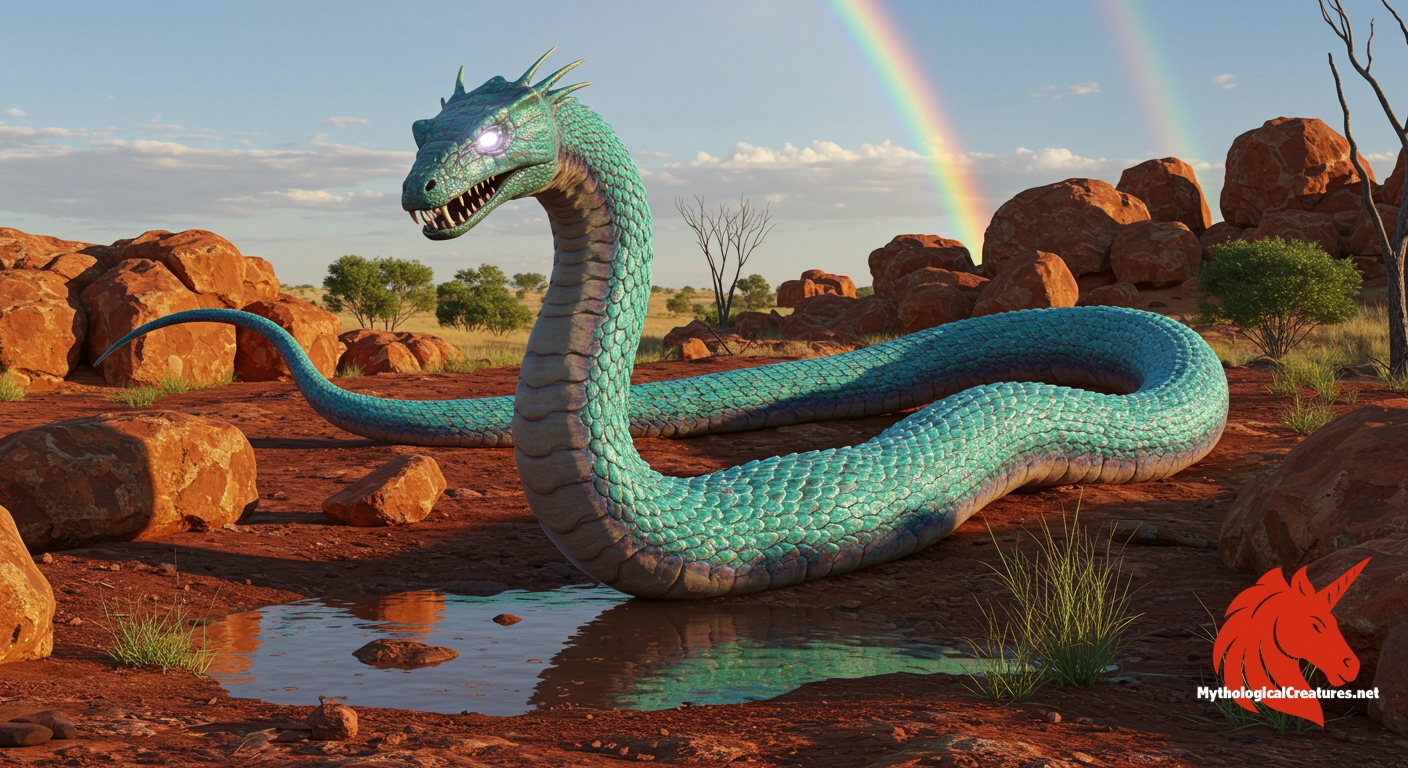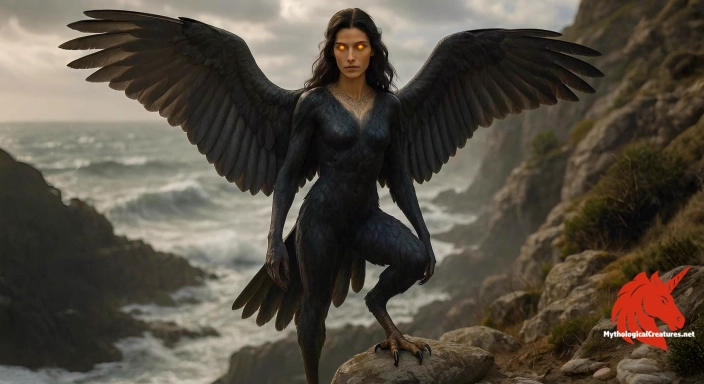Wollunqua: Wollunqua is a colossal snake-god of rain and fertility in Australian Aboriginal mythology, revered as a totemic ancestor by the Warramunga people.

Wollunqua
Wollunqua - Wollunqua is central to rituals of rain and fertility and is revered as the great father of the snakes, serving as a cultural and ancestral guide for the Warramunga people.
Origins & First Encounters
The Wollunqua is celebrated as a mighty snake-god of rain and fertility within the rich spiritual tapestry of the Warramunga people, symbolising nature’s profound capacity for creation and renewal. It is depicted as a totemic ancestor whose origin is shrouded in the mystical Wingara time, a period of dreamtime and primordial events. Emerging from the sacred watering hole of Kadjinara nestled in the Murchison Ranges, the deity’s arrival marked the forging of deep bonds between the land and its people. This divine serpent is recognised as a unique variant of the broader Rainbow Serpent motif that resonates across various Aboriginal traditions. Its true name, when spoken in secrecy, is considered dangerous and potent enough to unleash uncontrolled forces, hence a euphemistic title is preferred in public discourse. As a guardian of rain and fertility, Wollunqua’s existence reinforces the essential connection between water, the earth, and human sustenance. The legend intertwines themes of creation, transformation, and the sacred responsibility of maintaining balance in nature. Through centuries of oral tradition, Wollunqua has become a central cultural symbol, encapsulating the enduring interplay between myth, identity, and the majestic landscape of Australia.
Source Texts & Tale Variants
The lore of Wollunqua has been meticulously preserved through the oral narratives of the Warramunga people, where the power of storytelling safeguards ancient wisdom. Stories about the great snake-god have been passed along through generations, each rendition adding layers of depth and meaning. These vivid accounts recount its epic journey from the sacred water sources, intertwining natural landmarks with moments of cosmic importance. Some versions of the myth detail Wollunqua’s emergence from the earth and subsequent underground travels, while others focus on its dramatic surface manifestations. Variants of the narrative even explain differing methods of travel, such as the emphasis on subterranean pathways that culminate in miraculous ceremonies. This diversity in storytelling reflects the dynamic nature of oral traditions, where local custodians adapt the narrative to convey both historical and contemporary values. Ritual chants, ceremonial dances, and songlines further complement these narratives, ensuring that every aspect of Wollunqua’s myth is intricately interwoven with the community’s cultural life. The multiplicity of these sources creates a rich mosaic of belief that continuously evolves while remaining anchored in ancient ceremonial practice.
Form & Powers
Descriptions of Wollunqua vividly portray it as a serpentine being of immense proportions, an entity whose body is so long it is said to span many miles across the rugged landscape. Its form is fluid and ever-changing, a quality that mirrors the mercurial nature of the rain it commands and the fertility it bestows. The creature is often envisaged with scales that shimmer in an array of colours, reminiscent of the delicate hues of a rainbow stretched across the sky. This radiant, almost luminescent quality not only symbolises its connection with water but also highlights the interplay between light and natural forces. In various depictions, the head of the snake emerges from the earth while its elongated tail remains hidden or recedes underground, a physical duality that underscores its mysterious presence. The undulating movements of Wollunqua evoke the sinuous flow of water, reinforcing its role as a nurturer of life and transformer of arid landscapes. Its size and scale are presented as both a marvel and a warning, signifying the overwhelming power of nature. Each feature of its form, from the graceful curvature of its body to the dazzling display of its colours, invites observers to reflect on the sweeping beauty and inherent might of the natural world.
Regional Faces
The interpretation of Wollunqua varies significantly across regions, with each Aboriginal community tailoring the myth to reflect local environments and cultural priorities. Among the Warramunga, the snake is venerated as a central ancestral figure, while other groups integrate similar serpent deities into their own diverse cosmologies. Some regions place greater emphasis on Wollunqua’s subterranean journeys and underground ceremonies, aligning with the hidden aspects of fertility and renewal. In other areas, the serpent’s manifestation in the exterior world is highlighted, particularly in its creation of rainbows that bridge the heavens and the earth. These regional adaptations extend to variations in the ritual practices and ceremonial sites associated with Wollunqua’s wanderings. Local legends may incorporate distinct geographical features, thereby weaving the creature’s narrative with the specific landforms and water sources of the area. Artistic expressions, from rock art to ceremonial performances, further embed these regional beliefs into a collective cultural memory. Such diversity elucidates how the myth of Wollunqua is not static but continuously evolves to reflect the intimate and dynamic relationship between indigenous peoples and their unique landscapes.
Cultural Parallels
The myth of Wollunqua shares compelling similarities with serpent deities found in diverse cultures around the world, drawing intriguing parallels that transcend geographical boundaries. Much like the Rainbow Serpent of other Aboriginal traditions, Wollunqua embodies the duality of creation and destruction, emphasising the cyclical nature of life. This creature mirrors aspects of the feathered serpent found in Mesoamerican myth, where the blending of earth and celestial elements underscores profound spiritual truths. Similarly, traditions from South and Southeast Asia depict nāgas as powerful water guardians, reflecting a shared reverence for serpentine forms that control rain and fertility. Both Wollunqua and these other mythological snakes serve as bridges between the tangible environment and the metaphysical realm of spirituality. Their narratives often articulate themes of transformation, balance, and the interdependence of life’s natural cycles. The recurrent motif of a mighty snake governing water and earth illustrates that, despite cultural differences, these legends speak to a universal human experience of awe and reverence for nature’s vast forces. By juxtaposing Wollunqua with its global counterparts, one can appreciate a rich dialogue among world mythologies that celebrates the mysterious and omnipotent character of the serpent.
Legacy & Modern Evolution
Over the centuries, the myth of Wollunqua has undergone a vibrant transformation, evolving from an exclusively oral tradition into a symbol that permeates modern indigenous identity and artistic expression. Once confined to the domains of ritual and spiritual practice, the deity’s image now appears in contemporary artworks, literature, and public discourse, serving as an emblem of both cultural pride and environmental ethos. Modern interpretations often highlight Wollunqua’s dual role as a guardian of natural resources and a keeper of ancestral wisdom, thus reinforcing its relevance in today’s world. Contemporary artists reimagine the creature through various media, blending traditional iconography with modern visual techniques to explore themes of resilience and renewal. As communities seek to reclaim and rejuvenate their heritage, Wollunqua’s narrative underscores the importance of reconnecting with the land and preserving ancient wisdom. This evolving legacy is also evident in the renewed focus on environmental conservation, where the snake-god is revered as a reminder of the delicate balance between the natural world and human responsibility. Academic discourse and indigenous activism have further cemented its position as a symbol of renewal in the face of modern challenges. In this way, the myth of Wollunqua continues to inspire new generations, fostering an enduring dialogue between tradition and modernity.
Interesting Fact
An intriguing aspect of Wollunqua's myth is the taboo against speaking his true name too frequently, as doing so is believed to unleash his wrath and bring about calamity.
Quick Creature Info
Origin:
Features:
Associations:
Our Mythic Legendary Rating:

Also Sometimes Known As:
Habitat:
Supernatural Powers:
Physical Attributes:
Abilities:
Behavior:
Lore:
Related Creatures, Tales or Lore
- RRainbow Serpent
- QQuetzalcoatl
- NNaga
References
Discover Another Mythical Legend You May Not Have Heard Of?
Uncover the mysteries of ancient folklore and expand your knowledge of legendary beings from cultures around the world.
Dare to Meet the Celaeno....
Mythical Disclaimer: The images and data on this site are derived from various historical and literary sources, but we have found that many myths often have multiple versions and interpretations across references, sometimes contradictory. As a result, these creature depictions are artistic interpretations—imaginative blends of folklore, legend, and a dash of AI guesswork. Because creature descriptions vary widely, our illustrations and accompanying information represent our best effort to honor mythology while bridging creative gaps. Enjoy these interpretations—just remember, we've done our best to respect the stories and validate available data, but in the realm of mythology, details often shift, imagination leads the way, and nothing is ever set in stone!
Curated by the Mythological Creatures Team (rev. May 2025)
